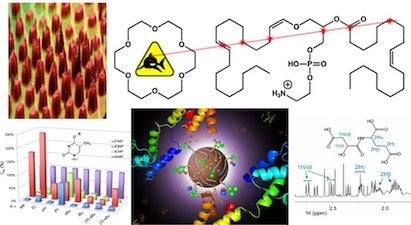As one of the first programs in California to offer an Analytical Chemistry degree, UCR has a rich history and is well-known in the field. We offer the broadest selection of coursework and bioanalytical training available in California. Students have access to state-of-the-art instrumentation, which they will use to develop methods for acquiring chemical measurements in complex systems. UCR Analytical Chemistry graduates are well-positioned to acquire jobs in the pharmaceutical and biotech industries, as well as academia.
At UCR, graduate study in Analytical Chemistry spans diverse instruments, applications, and molecular targets including atmospheric organics, proteins, lipids, DNA, RNA, oligosaccharides, and metabolites. Graduate students working in the Cheng, Genereux, Julian, Wang, H. Zhang, and Zhong research groups have the opportunity to gain expertise in a variety of important instrumental methods including biosensors, fluorescence spectroscopy, mass spectrometry, NMR spectroscopy, separations and surface plasmon resonance to address a variety of interesting and important problems. Although their primary focus is in another area, Professors Bardeen, Bartels, Mueller, Yin, Zaera, and J. Zhang have research projects of interest to analytical students.
Faculty Research Descriptions:
Christopher Bardeen
The Bardeen Lab uses time-resolved laser spectroscopy and advanced microscopy methods to look at dynamics in complex chemical systems. Areas of research include DNA motion in living cells and energy transport in organic semiconductors.
Ludwig Bartels
The Bartels group employs and develops a variety of analytical techniques. Foremost, we build and use scanning tunneling microscopes in ultra high vacuum under cryogenic conditions for the atomic scale analysis of surfaces and surface reactions. We also employ laser spectroscopy (ultra-fast, Raman, photoluminescence, etc.) both in vacuum and under ambient conditions. Additionally, the Bartels lab operates an XPS/UPS system for photoelectron spectroscopy and characterization of the composition of 2D materials.
Quan Jason Cheng
Research in the Cheng lab focuses on bio- and chemical sensors, functional biomaterials, and label-free surface plasmon resonance (SPR) techniques. We are particularly interested in measurement techniques involving supported lipid membranes, protein microarrays, surface-assisted MS methods, and novel platforms allowing orthogonal detection.
Emma Rova Danelius
The Danelius Lab uses the cryo-EM method MicroED and NMR to solve structures and conformations of dynamic ligands and their biological targets. One focus is on the discovery of new modalities beyond the traditional drug space, where conformational flexibility is important for activity and interactions. MicroED is an electron diffraction technique for the analysis of atomic structures from nanosized crystals. It offers new possibilities to determine challenging structures directly from powder formulations and can even be applied to compound mixtures.
James Davies
Our group uses mass spectrometry and light scattering to explore the chemical and physical nature of atmospheric aerosol. Using single particle levitation instruments developed in our lab, we probe processes on single droplets and characterize the link between evolving composition and physical characteristics, in order to better understand the role of aerosol in the atmosphere and environment.
Joseph Genereux
Cellular stresses can interfere with protein folding and trafficking, threatening cellular health. However, we have limited technology to characterize which proteins are impacted by threats to protein homeostasis. Our laboratory develops quantitative proteomics approaches to identify proteome-wide misfolding and mistrafficking in response to stress.
Ryan Julian
Mass spectrometry is one of the pillars of analytical chemistry and is central in the Julian group. Projects range from the study of protein aging (in relation to cataracts, Alzheimer’s and Parkinson’s) to determination of three-dimensional protein structure (and everything in-between). Students gain experience with instrumentation, chemical synthesis, computational chemistry, and bioinformatics. Experts in mass spectrometry with these attributes are highly desired in the pharmaceutical industry and in many other jobs.
Leonard Mueller
Solid-state and solution-state NMR as a probe of structure and dynamics.
Yinsheng Wang
Biological applications of mass spectrometry; reactive oxygen species induced nucleic acid damage.
Yue Wu
The overarching goal of our research is to advance high-throughput bioanalytical chemistry through the development of innovative optical and molecular barcoding technologies, integrating photonic materials, imaging, and omics approaches.
Yadong Yin
The Yin group is interested in the development of functional colloidal nanostructured materials with unique photonic, electronic, catalytic, and surface properties for analytical and biomedical applications. Our recent research work includes the design of mesoporous materials for bioseparation, metal nanostructures for surface plasmon resonance based biosensing, and hybrid materials for heavy metal detection and removal.
Francisco Zaera
Surface chemistry with emphasis on heterogeneous catalysis and materials science; use of several surface sensitive techniques including RAIRS, TPD, XPS, ISS, AES, LEED and SIMS together with molecular beams for kinetic measurements.
Jingsong Zhang
Our research focuses on the oxidation processes of tropospheric volatile organic compounds (VOCs). We are interested in developing sensitive optical instruments for ambient measurements of atmospheric trace species and free radicals. We utilize multi-pass absorption techniques, cavity ring-down spectroscopy (CRDS) and cavity enhanced spectroscopy (CEAS), for these atmospheric measurements. We also use spectroscopy and mass spectrometry methods to study chemical kinetics and mechanisms of tropospheric oxidation reactions of VOCs. We are also interested in green house gas (GHG) measurements in California.
Haofei Zhang
Our research focuses on understanding the multiphase physiochemical processes that lead to the formation and evolution of organic aerosol in the atmosphere. In the long term, we want to understand how organic aerosol impacts climate and human health.
Linlin Zhao
The overarching goal of our research is to decipher the mechanisms of mitochondrial DNA turnover and repair and clarify their roles in mitochondrial pathogenesis. We combine mass spectrometry-based bioanalytical approaches with protein biochemistry, mechanistic enzymology, and cellular approaches to gain quantitative insights into the mitochondrial DNA maintenance process. We envision that the new knowledge from our research will further the understanding of mitochondrial pathology and inform the development of novel therapeutics for mitochondrial diseases.
Companies and Academic Institutions that have employed our graduates:
Graduates of the UCR Analytical Chemistry program find excellent job opportunities in the Chemical, Biotechnology and Pharmaceutical industries. For example, the following list contains companies and academic institutions that have employed UCR Analytical Chemistry Ph.D. graduates and postdoctoral researchers.

